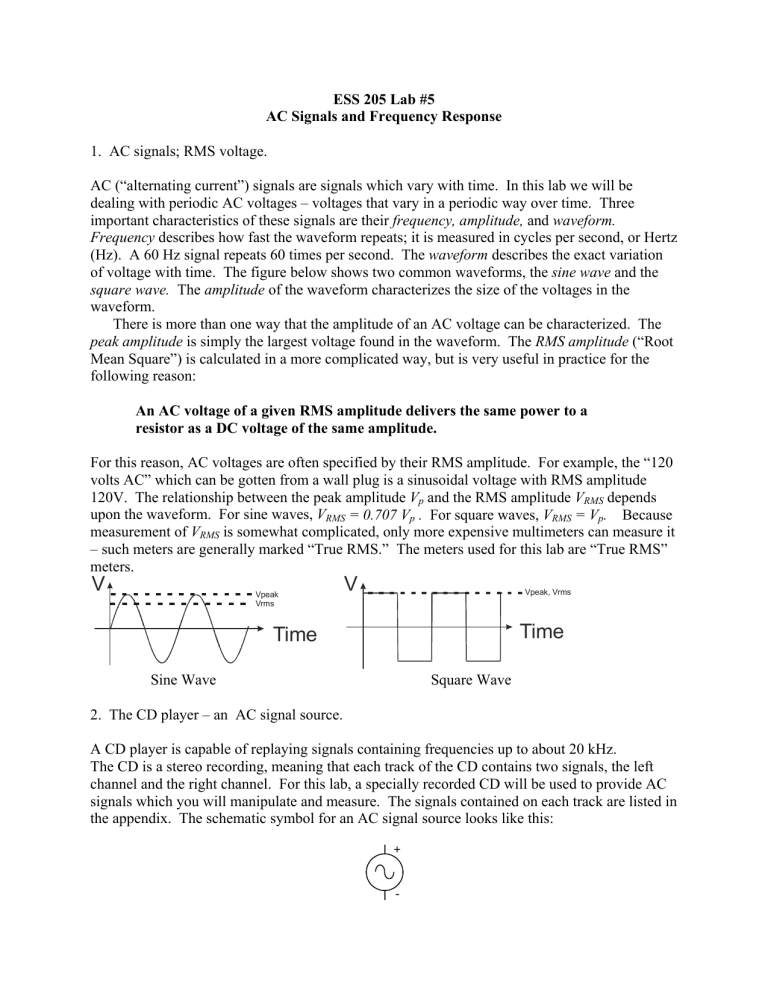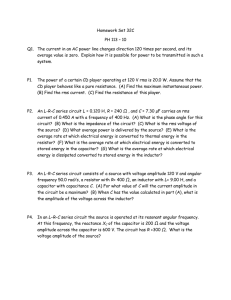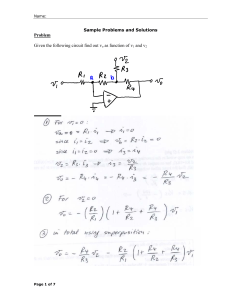V Time Time

1. AC signals; RMS voltage.
ESS 205 Lab #5
AC Signals and Frequency Response
AC (“alternating current”) signals are signals which vary with time. In this lab we will be dealing with periodic AC voltages – voltages that vary in a periodic way over time. Three important characteristics of these signals are their frequency, amplitude, and waveform.
Frequency describes how fast the waveform repeats; it is measured in cycles per second, or Hertz
(Hz). A 60 Hz signal repeats 60 times per second. The waveform describes the exact variation of voltage with time. The figure below shows two common waveforms, the sine wave and the square wave. The amplitude of the waveform characterizes the size of the voltages in the waveform.
There is more than one way that the amplitude of an AC voltage can be characterized. The peak amplitude is simply the largest voltage found in the waveform. The RMS amplitude (“Root
Mean Square”) is calculated in a more complicated way, but is very useful in practice for the following reason:
An AC voltage of a given RMS amplitude delivers the same power to a resistor as a DC voltage of the same amplitude.
For this reason, AC voltages are often specified by their RMS amplitude. For example, the “120 volts AC” which can be gotten from a wall plug is a sinusoidal voltage with RMS amplitude
120V. The relationship between the peak amplitude V p and the RMS amplitude V
RMS depends upon the waveform. For sine waves, V
RMS
= 0.707 V p
. For square waves, V
RMS
= V p
. Because measurement of V
RMS is somewhat complicated, only more expensive multimeters can measure it
– such meters are generally marked “True RMS.” The meters used for this lab are “True RMS” meters.
V
Vpeak
Vrms
Vpeak, Vrms
Time Time
Sine Wave Square Wave
2. The CD player – an AC signal source.
A CD player is capable of replaying signals containing frequencies up to about 20 kHz.
The CD is a stereo recording, meaning that each track of the CD contains two signals, the left channel and the right channel. For this lab, a specially recorded CD will be used to provide AC signals which you will manipulate and measure. The signals contained on each track are listed in the appendix. The schematic symbol for an AC signal source looks like this:
+
-
3. The audio amplifier – an AC measurement device
The PC speakers used in this lab take a signal, amplify it, and apply it to the voice coils of the speaker. The voice coil displaces the speaker cone by a distance proportional to the input signal.
Applying an AC signal to the speaker input generates audible vibrations in the air; the ear is sensitive to vibrations ranging from about 20 Hz to 20 kHz. The schematic symbol for the speaker looks like this:
The PC speakers used in the lab also two channels. Each group will need only one channel, so one set of speakers can be used by two groups at the same time.
Attach the speaker input to the left channel of the CD player and listen to sine waves of various frequencies. Make sure that the “anti-shock” or “skip protection” feature is set to OFF. Which ones can you hear? Which ones sound the loudest? How does the sound of a sine wave compare to the sound of the square wave recorded in the right channel?
+
-
Circuit for part 3.
4. The RMS voltmeter – another AC measurement device
An RMS voltmeter set to measure “AC voltage” will report the RMS voltage of an input AC waveform. The schematic symbol for an AC voltmeter looks like this:
V
Add the RMS voltmeter to the circuit, as shown below. For the 1 kHz sine wave, what range of
RMS voltages does the CD player generate as you adjust the volume control? The voltmeter can also be used to measure the frequency of the input signal. Measure the frequency of some of the signals on the CD. How well do the measurements compare to the nominal frequencies listed in the appendix?
+
V
-
Circuit for part 4.
5. Frequency response
As recorded on the CD, each sine wave has exactly the same amplitude. If the CD player was perfect, the circuitry in the CD player would turn the digital information recorded on the CD into output signals with exactly the same amplitude. The actual response of the CD player will vary with the frequency of the output signal; this variation is called the “frequency response” of the
CD player. Set the output of the CD player to be close to the middle of its range at 1 kHz.
Then, measure the CD player’s output at other frequencies and generate a graph of the CD player’s frequency response. Make sure the “bass boost” switch is OFF. How much variation in output amplitude do you observe? Does the CD player seem to be better at reproducing amplitude or frequency? Why do you think this is?
Repeat the measurements and make a second plot with the “bass boost” switch ON. How does this change the frequency response?
6. RC filters
The CD player’s “Bass Boost” is an example of a filter – a circuit which has a response which varies with frequency. A passive filter is built using only resistors, capacitors, and inductors.
One very common type of filters is the RC filter, shown below. Measure the output of the circuit as a function of frequency. Change the capacitor to 0.05
µ
F. How does this affect the frequency response?
10 k
Ω
+
V
-
Circuit for part 6.
This RC circuit is a “low-pass” filter. It is very commonly used to reduce noise in measurement circuits. It works because the capacitor acts like a frequency-dependent resistor (or more properly, a frequency dependent impedance.
) Specifically, its impedance to current flow is inversely proportional to the frequency. The RC filter can then be understood as a voltage divider in which one of the resistors is frequency dependent.
7. Loading
Add the speaker in parallel with the RMS voltmeter. How does this affect the measurements?
10 k
Ω
+
V
-
Circuit for part 7.
This effect is called loading. It happens because the speaker input “looks like” a resistor to the rest of the circuit. (In technical terms, the speaker has a relatively low “input impedance.”)
This is a very important effect in electronics – adding an element to a will in general affect the rest of the circuit through loading effects. Test equipment like voltmeters and oscilloscopes are generally designed to minimize these effects (have a high input impedance.) This is why a voltmeter can be used for measurements without worrying too much about loading effects.
Appendix – Signal generator CD track contents
Left channel – sine wave; Right channel – square wave
1 1000
Track f, Hz
21 2000
2 10
3 20
4 30
5 40
6 50
7 60
8 70
22 3000
23 4000
24 5000
25 6000
26 7000
27 8000
28 9000
9 80
10 90
11 100
12 200
13 300
14 400
15 500
16 600
17 700
18 800
19 900
20 1000
29 10000
30 11000
31 12000
32 13000
33 14000
34 15000
35 16000
36 17000
37 18000
38 19000
39 20000



